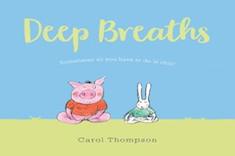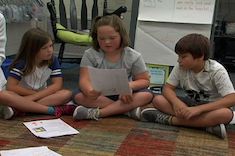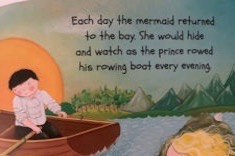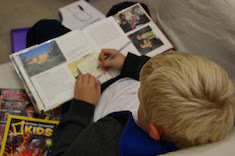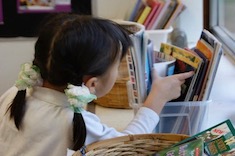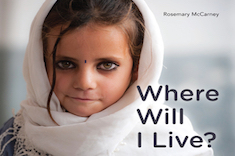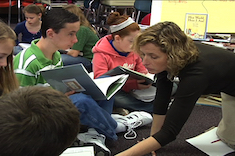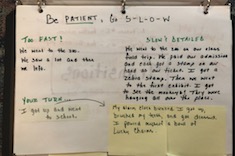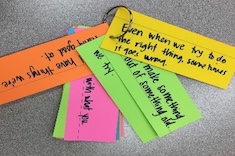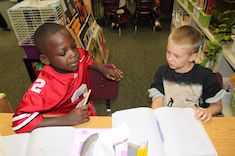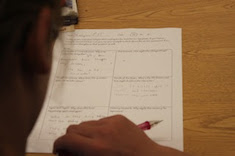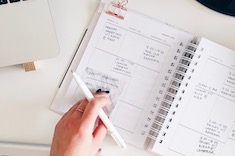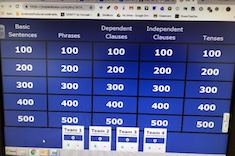3rd
Latest Content
Picture Books for Mental Wellness
Mandy Robek learns a lot about worry from her daughter, and discovers a treasure trove of picture books to promote mental wellness and help students cope with difficult emotions.
Socratic Discussion in Third Grade
Lora Bieghler facilitates a Socratic-style discussion among third graders.
Letting Students Organize Informational Books
Mandy Robek is a little nervous about setting her students loose to organize informational texts, but she couldn’t be more pleased by what they learn in the process.
Out of Sight, Out of Mind: Accountability for Young Writers
Stella Villalba teaches young writers about writer’s craft. So how come evidence of learning from the minilessons isn’t showing up when she confers with her students? She decides to develop a plan to help students link craft lessons with their writing.
Navigating the Interpretation Process
Tammy Mulligan shares how she introduces students to the process of interpreting literature at different grade and developmental levels.
Reassuring Worried Children with Picture Books
Mandy Robek learns a lot about worry from her daughter, and at the same time discovers a treasure trove of children’s books to help students overcome worries.
Interpretation and Comprehension
Teaching comprehension skills can be a complex and overwhelming task. Tammy Mulligan shares a process for expanding and deepening student interpretations of text.
Remembering the Big Picture in Reading Assessments
Kate Mills notes her own miscues in reading a bedtime story to her young children, and thinks about what that means for analyzing the running records of readers in primary classrooms.
Making Learning Stick: Learning Progressions and Student-Created Exemplars
Tammy Mulligan explains the process of having students analyze and create models of good writing and analysis for assessing themselves and peers.
Teaching Constructed Response Before Exams
Teaching the genre of tests can seem far removed from writing workshop. Matt Renwick explores how to teach constructed response in a way that is integrated with the tenets of good workshop instruction.
Reading Mats Build Confidence
Tammy Mulligan explains how the use of the popular “reading mats” can help build reader confidence.
When Learning Gets Tricky, Go Back to the Pigs
Whenever a tricky literary concept comes up, Tammy Mulligan finds herself returning to a favorite mentor text to guide students. She explains the value of shared simple stories for understanding complicated literary elements.
Teaching Conventions in Small Groups
Dana Murphy finds it is best to teach conventions in small, targeted groups in her fifth-grade classroom. She explains how she designs and leads these groups.
Building Reading Identities Across the Year
The start of the school year is often all about building reader identities in classrooms. And then October comes, and many of the activities that help students celebrate their reading histories and preferences are forgotten. Tara Barnett and Kate Mills share ways teachers can continue to help students define, refine, and expand their reading identities all year long.
Text Sets: Reading Beyond Just Facts
Franki Sibberson explains how carefully curated text sets can help students move beyond a “just the facts” exploration of nonfiction topics.
Finding Time for Writing Shares
Finding time for writing share sessions may begin with trying out a few different options to see what works in your classroom. Melanie Meehan presents some of her favorites.
The Power of Video Replay
Heather Fisher explains how viewing excerpts from the same video multiple times can help students in book clubs hone their conversation and reflection skills.
Book Club Tools
Tammy Mulligan shares the importance of giving students choice and agency with book club tools to improve engagement and the quality of the conversations.
Moving from Interactive Read Alouds to Book Clubs
Tammy Mulligan shares how teachers can move seamlessly from thoughtful conversations during whole-class read alouds to lively book clubs.
Grand Conversations and Read Aloud
Are your conversations during read aloud stilted or shallow? Tammy Mulligan recommends weekly “grand conversations” to spark more thoughtful talk. She provides the tools you need to get started in your classroom.
Interactive Read Aloud and the Whole-Class Notebook
Tammy Mulligan enhances the quality of the class read aloud and student discussions with the use of a whole-class response notebook.
Young Learners and Self-Talk
Do you have young readers and writers in your class who constantly talk to themselves? Stella Villalba helps a teacher decode the value of this self-talk for first grader Kayla, using it as a springboard for more learning.
Using a Strategy Notebook in Small-Group Instruction
So many needs for groups, and so little time. Dana Murphy finds that a strategy notebook is invaluable as a teaching aid in her fifth-grade small groups.
Growing Talk About Reading
Tara Barnett and Kate Mills find that struggling readers in the early grades benefit from scaffolds and repeated practice in small groups. They share some of their favorite tools, including key ring prompts and anchor charts.
Talking Through Characters
Melanie Meehan shares activities that help students talk about their characters before writing about them in a realistic fiction unit.
Alternatives to Graphic Organizers
Dana Murphy is dismayed by the ways graphic organizers can sometimes limit student creativity. She uses writing notebooks and a few other strategies to begin to wean her fourth graders from depending too much on organizers.
Forming Groups Using a Planner
Dana Murphy explains how her small-group planner is an essential tool for organizing groups in her fourth-grade classroom.
Getting Started with Strategy Lessons
Tara Barnett and Kate Mills describe how they help teachers move from guided reading to strategy groups in the upper elementary grades.
Revising Dialogue in Narrative Writing
Melanie Meehan finds that a “lift the flap” strategy works for showing students different revision options with dialogue.
Grammar Games
Melanie Meehan shares two of her favorite games for teaching grammar, including templates and web resources.
Browse Content By
Type
Category
- Assessment Tools
- Big Fresh Archives
- Booklists
- Choice Numeracy
- Classroom Design
- Common Core
- Community Building
- Conferring
- Content Literacy
- Digital Literacy
- English Language Learners
- Equity
- Family Relations
- Free Samples
- Guiding Groups
- Leadership
- Literacy Coaches
- Mentor Texts
- Minilessons
- New Teacher Mentors
- Podcasts
- Poetry
- Quote Collections
- Reading Strategies
- Self Care
- Struggling and Striving Learners
- Talking and Listening
- Teacher Study Groups
- Teaching Reading
- Teaching Writing
- Word Study and Vocabulary
Author
- Melissa Quimby
- Nawal Qarooni
- Gwen Blumberg
- Julie Cox
- The Lead Learners
- Hannah Tills
- Josie Stewart
- Ruth Metcalfe
- Mallory Messenger
- Becca Burk
- Jodie Bailey
- Vivian Chen
- Mary Brower
- Tiffany Abbott Fuller
- Stephanie Affinito
- Ruth Ayres
- Leigh Anne Eck
- Heather Fisher
- Shari Frost
- Julie Johnson
- Suzy Kaback
- Gigi McAllister
- Shirl McPhillips
- Melanie Meehan
- Cathy Mere
- Debbie Miller
- Tara Barnett and Kate Mills
- Tammy Mulligan
- Dana Murphy
- Bitsy Parks
- David Pittman
- Brenda Power
- Heather Rader
- Matt Renwick
- Mandy Robek
- Christy Rush-Levine
- Gretchen Schroeder
- Jen Schwanke
- Brian Sepe
- Katherine Sokolowski
- Stella Villalba
- Jennifer Vincent
Grade Level
Choice Literacy Membership
Articles
Get full access to all Choice Literacy article content
Videos
Get full access to all Choice Literacy video content
Courses
Access Choice Literacy course curriculum and training

